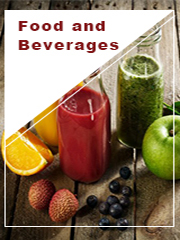Report overview
Natural food flavors include the essential oil, oleoresin, essence or extractive, or any products from roasting or heating, which is derived from plants. Natural food flavors can enhance the food flavor and make it more delicious.
The products which only sold in the market are covered in this report.
Natural food colors are dye, pigment or substance that imparts color when it is added into food. They are mainly made from the natural plants and come in many forms consisting of liquids, powders, gels, and pastes. Natural food colors are used both in commercial food production and domestic cooking.
This report aims to provide a comprehensive presentation of the global market for Natural Food Flavors and Colors, with both quantitative and qualitative analysis, to help readers develop business/growth strategies, assess the market competitive situation, analyze their position in the current marketplace, and make informed business decisions regarding Natural Food Flavors and Colors. This report contains market size and forecasts of Natural Food Flavors and Colors in global, including the following market information:
Global Natural Food Flavors and Colors Market Revenue, 2018-2023, 2024-2029, ($ millions)
Global Natural Food Flavors and Colors Market Sales, 2018-2023, 2024-2029, (MT)
Global top five Natural Food Flavors and Colors companies in 2022 (%)
The global Natural Food Flavors and Colors market was valued at US$ 5184.3 million in 2022 and is projected to reach US$ 5804.3 million by 2029, at a CAGR of 1.6% during the forecast period. The influence of COVID-19 and the Russia-Ukraine War were considered while estimating market sizes.
At present China, Asia, America and Europe are the major manufacture areas. Especially for Asia, the market share is 45%, Synthite, Gajanand, Haldin are the major players in Asia. At the same time Asia is the major food flavors consumption area, about 31% for the total global consumption. China is second production area and consumption area.
Natural food colors production concentrated in China, Europe, America and Asia (Excluding China), accounting for 63%, 18%, 7%and 5% of the global production market share. DDW, Qianhe, Sethness are the global leading manufacturers of natural food colors.
We surveyed the Natural Food Flavors and Colors manufacturers, suppliers, distributors and industry experts on this industry, involving the sales, revenue, demand, price change, product type, recent development and plan, industry trends, drivers, challenges, obstacles, and potential risks.
Total Market by Segment:
Global Natural Food Flavors and Colors Market, by Type, 2018-2023, 2024-2029 ($ Millions) & (MT)
Global Natural Food Flavors and Colors Market Segment Percentages, by Type, 2022 (%)
Vegetable Flavor
Fruit Flavor
Spices
Natural Food Colors
Caramel Color
Lutein
Capsanthin
Others
Global Natural Food Flavors and Colors Market, by Application, 2018-2023, 2024-2029 ($ Millions) & (MT)
Global Natural Food Flavors and Colors Market Segment Percentages, by Application, 2022 (%)
Beverage
Sweet
Savory
Others
Global Natural Food Flavors and Colors Market, By Region and Country, 2018-2023, 2024-2029 ($ Millions) & (MT)
Global Natural Food Flavors and Colors Market Segment Percentages, By Region and Country, 2022 (%)
North America
US
Canada
Mexico
Europe
Germany
France
U.K.
Italy
Russia
Nordic Countries
Benelux
Rest of Europe
Asia
China
Japan
South Korea
Southeast Asia
India
Rest of Asia
South America
Brazil
Argentina
Rest of South America
Middle East & Africa
Turkey
Israel
Saudi Arabia
UAE
Rest of Middle East & Africa
Competitor Analysis
The report also provides analysis of leading market participants including:
Key companies Natural Food Flavors and Colors revenues in global market, 2018-2023 (Estimated), ($ millions)
Key companies Natural Food Flavors and Colors revenues share in global market, 2022 (%)
Key companies Natural Food Flavors and Colors sales in global market, 2018-2023 (Estimated), (MT)
Key companies Natural Food Flavors and Colors sales share in global market, 2022 (%)
Further, the report presents profiles of competitors in the market, key players include:
Synthite
Gajanand
Ungerer & Company
Kotanyi
McCormick
Givaudan
DSM
Dharampal Satyapal Group
Fuchs
TAKASAGO
Haldin
KIS
Symrise
Sensient
Prova
Akay Flavous and Aromatics
San-Ei-Gen
Nilon
MDH Spices
Mane SA
AVT Natural
Everest Spices
WILD
International Flavors?Fragrances
ACH Food Companies
Synergy Flavors
Plant Lipids
Wang Shouyi
Anji Foodstuff
Yongyi Food
Zhejiang Zhengwei
Huabao Group
Guangxi Zhongyun
Chenguang Biotech Group
Chunfa Bio-Tech
Outline of Major Chapters:
Chapter 1: Introduces the definition of Natural Food Flavors and Colors, market overview.
Chapter 2: Global Natural Food Flavors and Colors market size in revenue and volume.
Chapter 3: Detailed analysis of Natural Food Flavors and Colors manufacturers competitive landscape, price, sales and revenue market share, latest development plan, merger, and acquisition information, etc.
Chapter 4: Provides the analysis of various market segments by type, covering the market size and development potential of each market segment, to help readers find the blue ocean market in different market segments.
Chapter 5: Provides the analysis of various market segments by application, covering the market size and development potential of each market segment, to help readers find the blue ocean market in different downstream markets.
Chapter 6: Sales of Natural Food Flavors and Colors in regional level and country level. It provides a quantitative analysis of the market size and development potential of each region and its main countries and introduces the market development, future development prospects, market space of each country in the world.
Chapter 7: Provides profiles of key players, introducing the basic situation of the main companies in the market in detail, including product sales, revenue, price, gross margin, product introduction, recent development, etc.
Chapter 8: Global Natural Food Flavors and Colors capacity by region & country.
Chapter 9: Introduces the market dynamics, latest developments of the market, the driving factors and restrictive factors of the market, the challenges and risks faced by manufacturers in the industry, and the analysis of relevant policies in the industry.
Chapter 10: Analysis of industrial chain, including the upstream and downstream of the industry.
Chapter 11: The main points and conclusions of the report.
